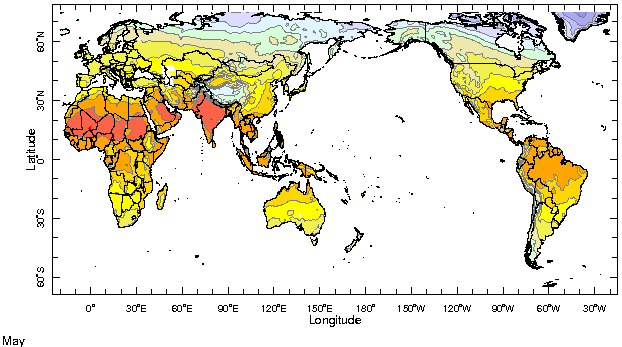|
IRI Climate Digest
June 2002
May Global Climate Summary
Climatological Background
In May, the sun is well into its march north of the equator (the maximum northward location will be achieved in June at 23.6 degrees north). Surface heating of the continents are setting the stage for summer monsoonal systems or northern hemisphere warm season rains. The lack of direct solar heating in the southern hemisphere creates a north-south temperature difference which strengthens mid-latitude storm tracks and the approach of winter.
Monthly Mean Temperature (1961-1990), data from the Climate Research
Unit, University of East Anglia


Monthly Mean Precipitation (1961-1990), data from the Climate Research
Unit, University of East Anglia


Temperatures
Colder than average temperatures continued for a third month over central and western Canada, while almost all of the rest of the continental landmasses, except for eastern Eurpoe and the southern tip of South America, continued at average to above-average conditions (see the map of temperature persistence).
Europe and Asia: Warmer than average conditions occurred from Norway southwards to the Mediterranean and from Siberia southeastwards to the Pacific. Colder than average conditions occurred in the region of Kazakhstan.
North America: The main anomalies were the continued colder than average temperatures in Central Canada, with the colder temperatures extended into the northern US during May.
South America: Warmer than normal conditions continued across much of South America, except for the southern-most tip of the continent, which was colder than average.
Africa: Warmer than normal temperatures continued over the western and southeastern regions of the continent.
Australia: Above-average temperatures continued for a third month across central and western Australia.
Temperature Difference from the 1961-1990 mean, with data
from NCEP Climate Prediction Center, CAMS.


Precipitation
Regional-scale persistent deficits continued in eastern Australia, north-easern Europe, and the west-central United States, while small areas of persistent deficits continued in parts of both western and eastern Africa, Brazil, Central Asia, and Central America. Above-average precipitation continued in Venezuela and eastern China, while rains along the eastern coast of the U.S. provided some relief from the local drought.
Africa: Deficits occurred over much of central Africa, except for small regions of excess in Kenya and the Great Lakes region. In some regions, the May deficits were the third consecutive month of deficits.
South America: A third month of wetter than average conditions occured in the north of the continent, in Venezuela and northern Brazil, and in the southeast, in southern Brazil, Uruguay, and Argentina, bracketing a persistent area of deficits in central Brazil.
North America: Above-average rains brought modest drought relief to some areas of the eastern U.S., while deficits continued to worsen the drought in the central and western states.
Central America: An uneven distribution of both continued deficits and above-average rainfall was recorded throughout the region.
East and Southeast Asia: Greater than average rainfall continued in a swath from Shanghai southwest through Myanmar. Deficits continued in northern Taiwan, but the south and central provinces recieved heavy rains in the latter part of the month.
Southwest Asia: The wet season ended for much of Southwest Asia with continued deficits in western Iran and northern Afghanistan.
Australia and New Zealand: Deficits continued for a third month in eastern Australia and the north island of New Zealand.
Europe: Deficits continued for a third month in areas of northeastern Europe.
Precipitation Difference from 1961-1990 mean, with data
from NCEP Climate Prediction Center, CAMS-OPI.


Oceanic Conditions
Tropical Pacific: The equatorial Pacific continued to be slightly above average but not yet developed into a coherent, basin-wide El Nino pattern. Please see the latest IRI ENSO Update for a detailed summary and outlook.
Tropical Atlantic: The anomalies off of western Africa north of the equator changed to colder than average, while the anomalies south of the equator remained warmer than average, resulting in a large-scale gradient of anomalies in the eastern Atlantic. Warm anomalies continued off the southeastern coast of South America.
Indian Ocean: Surface temperatures remained warmer than average in the western half of the basin, continuing to cool in the east and to the north and south in the subtropics.
Mid latitudes: Warmer than average surface waters continued to dominate the midlatitudes around 30 degrees north and south of the equatorward, with modest cold anomalies poleward and eastward.
Monthly Sea Surface Temperature Difference from the 1950-1979 mean,
with data from the Environmental Modeling Center, NCEP/NOAA.


Contents |
Special |
Impacts |
Climate |
Forecast
|

